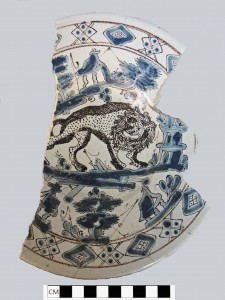Dr. Velasquez discussed her very interesting PhD research into changes in the ceramic craft industry in colonial Mexico from approximately the seventeenth century onwards in her talk entitled “Untainted lineages: Ceramic ware as a medium to explore the doctrine of blood purity in Colonial Mexico”. She examined ceramic assemblages from a number of sites in Mexico City that were ranked in terms of social status. Expensive ceramic tableware used at some of these sites included Chinese porcelain in addition to majolica ware, and Dr. Velasquez linked stylistic and ornamentation changes in these ceramics with social changes in colonial Mexico. Some of these social changes including a preference for strict religious piety and avoidance of decorative or gluttonous lust, including in food consumption and dining practices, may be correlated with the use of ‘pure’ tableware such as the white maiolica ceramics.
 This time in Mexico was a time of strict social attitudes and values to miscegenation, or racial or blood purity. Certificates to demonstrate a ‘pure’ bloodline or ancestry that did not include racial or ethnic mixing were required, some of which survive in museums to the present day. Strict Catholic religious practices were also observed, including at the beautiful Mexico City cathedral or Catedral Metropolitana de la Asunción de la Santísima Virgen María a los cielos(Metropolitan Cathedral of the Assumption of the Most Blessed Virgin Mary into Heaven)located atop the former Aztec sacred area of Templo Mayor. However, Hispanic social identity marks as an opposition to miscegenation included potters’ marks on the bases of pots as well as increased pottery guild activity.
This time in Mexico was a time of strict social attitudes and values to miscegenation, or racial or blood purity. Certificates to demonstrate a ‘pure’ bloodline or ancestry that did not include racial or ethnic mixing were required, some of which survive in museums to the present day. Strict Catholic religious practices were also observed, including at the beautiful Mexico City cathedral or Catedral Metropolitana de la Asunción de la Santísima Virgen María a los cielos(Metropolitan Cathedral of the Assumption of the Most Blessed Virgin Mary into Heaven)located atop the former Aztec sacred area of Templo Mayor. However, Hispanic social identity marks as an opposition to miscegenation included potters’ marks on the bases of pots as well as increased pottery guild activity.
As part of the strict religious observances of the time, Dr. Velasquez mentioned the debate concerning whether nuns should be able to drink hot chocolate. We look forward to her forthcoming paper regarding this ‘luciferous beverage’ which, it was thought, drove women to lust and wanton debauchery. We note with interest that there are some scientific studies to back this up (e.g., Ren et al 2014), so please keep the chocolate coming!
Written by Sheahan Bestel
References
Ren, Dongning, Kenneth Tan, Ximena B. Arriaga and Kai Qin Chan. 2014. Sweet love: The effects of sweet taste experience on romantic perceptions. Journal of Social and Personal Relationships 32(7): 905-921.

